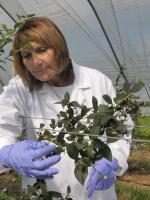Introduction
High value crops grown in Scotland (barley, potatoes and soft fruit) are susceptible to damage caused by a wide range of endemic diseases. In the future, these crops are likely to face additional disease challenges from new pests and pathogens due to factors including: the loss of key pesticides through legislation or reduced efficacy; increased global movement of diseased plant material and a changing climate. Integrated Pest Management (IPM) strategies aim to control diseases of particular crops or cropping systems using a combination of tools and approaches. Our research underpins IPM by delivering improved methods of detecting, identifying and quantifying the key pests, pathogens and diseases in a timely manner in ‘the field’. Using both current and emerging technologies we aim to develop diagnostics that are both relevant to stakeholder needs and fit for the future.
Aim of Research
The overall aim is to improve detection of economically important pests/pathogens/diseases affecting key Scottish crops. This will improve decision making for growers and control recommendations and inform policy and statutory recommendations, leading to improved disease control. Much of the research capitalises on outputs from the previous RESAS programme and externally funded research. The initial focus is primarily on developing/improving the necessary assays, tools and techniques. Subsequently, new detection methods will either be validated and incorporated directly into relevant IPM toolboxes or be deployed to develop disease risk assessments and/or forecasting to inform IPM strategies.
Progress
2021 / 2022
Research to develop new or improved diagnostics for key pests and pathogens for which in field detection is an essential component of an IPM approach to disease control continued into Year 6. The programme of work delivered in Year 6 comprised a combination of work planned for Year 5 which was rescheduled to Year 6 in response to Covid-19 disruptions, and some new areas of research aligned with the aims and objectives of the work programme. In particular, techniques to improve detection of Raspberry bushy dwarf virus (RBDV) were developed. Advances in detection of stress in blueberry and raspberry using hyperspectral imaging were made, and a bioinformatic tool to process single marker sequencing data was developed for multi marker capability.
Highlights:
Progress to improve detection of soft-fruit viruses was made through the construction of infectious clones of RBDV isolates able or unable to overcome resistance in raspberry. Examination of the behaviour of these clones will allow the production of a diagnostic test for the resistance breaking character in RBDV.
Hyperspectral imaging in blueberry to detect stress was collected. Fruit quality parameters were evaluated with hyperspectral imaging and conventional analysis and proxy signatures identified where results were comparable. Based on this research and the genetic components in RD2.1.2, new breeding programmes have been established to further support the UK industry.
For raspberry, images were collected and analysed for spectral signatures related to root rot from both controlled and on farm studies, architectural traits and quality traits. These were compared to physiological measures to start developing plant response mechanisms.
Advancements were made to bioinformatic tool for processing marker specific sequencing data which is being used to facilitate pathogen population studies. thapbi-pict · PyPI
2020 / 2021
The planned programme of work to develop new or improved diagnostics for key pests and pathogens for which in field detection is an essential component of an IPM approach to disease control continued in Year 5. Due to COVID-19 disruption some experimental work was modified from the anticipated field trials to glasshouse experiments and there was an additional focus on analysis of existing data sets. Progress was made on the detection of pathogens/pests and disease in potato, soft-fruit and barley. In particular, advances were made in Next Generation Sequencing (NGS) to investigate virus detection in soft fruit. Monitoring for Spotted Winged Drosophila (SWD) continued and new sensor technologies were evaluated on potato and soft fruit crops, and work began on hyperspectral imaging for disease detection in barley. The framework for monitoring the potential for new threats for which diagnostics could be required was consolidated within the SRP with links to the Scottish Plant Health Centre.
Highlights:
Soil cultivation practices to stimulate disease suppression. Data from work carried out at the CSC platform to investigate the incidence of seed and soil-borne potato pathogens detected under different soil management treatments led to a new line of research investigating the potential for soil management practices to create disease suppressive soils as reported in a SEFARI Case Study.
Next Generation Sequencing (NGS) to detect soft fruit viruses. A new cDNA synthesis method was adopted to prepare viral RNA for NGS using nanopore technology. The system has been used to carry out a detailed investigation of Rubus yellow net virus (RYNV) following an outbreak in the high health propagation collections.
Spotted Wing Drosophila (SWD) monitoring continued and a predictive model for SWD has been generated and its development for use as a potential growers’ tool is being assessed.
Hyperspectral imaging in raspberry. Continued progress is being made on detection of biotic and abiotic stresses using hyperspectral imaging in raspberry crops and a paper on its application to QTL detection has recently been published in Fruit Research
Leveraged Funding: Innovate UK Project. Establishment of optimal raspberry growing conditions integrated with early pathogen detection and control of PRR spread will transform raspberry agronomy, maximising yield and securing the UK soft fruit industry with application to other crops worldwide. Raspberry Auxin Soil/Substrate Protectant (RASP) IUK 48163.
2019 / 2020
New or improved diagnostics have been developed for key pests and pathogens for which in field detection is an essential component of an IPM approach to controlling disease in potato, cereals and soft fruits. New sensor technologies continued to be evaluated on potato and soft fruit crops. Previously developed software was updated for improved design of pathogen specific diagnostic assays. The framework for monitoring the potential for new threats for which diagnostics could be required was delivered through links to the Scottish Plant Health Centre.
Highlights:
An assay which had previously been validated for the detection of pathogenic Streptomyces spp. (a bacterial pathogen for which there are no chemical control options) in soil and on potato seed tubers was used to assess the relationship between pathogen detection and severity of disease in both glasshouse trials and in the field. This information will inform options for disease control.
Improved diagnostics for the detection and quantification of viruses affecting blueberry have been developed and are being deployed in pest and pathogen monitoring research, and in developing soft-fruit breeding programmes.
To understand the threat of the invasive Spotted Wing Drosophila (SWD) to the Scottish fruit industry, molecular markers were used to analyse DNA from five SWD populations (four Scottish, one Slovenian) providing a baseline reference in the soft fruit IPM toolbox, against which researchers can monitor populations over time. This will have particular relevance should SWD numbers change dramatically in future years.
A diagnostic assay has been developed for B. sorokinia, a pathogen which appeared in cereal crops in 2018. The assay is being used to investigate the movement of the pathogen spores in summer months in Scotland. New pathogen testing for emerging cereal diseases were included in a presentation on "Integrated control of barley" at Crop Production Northern Britain.
Research to assess the use of sensor technologies for early disease detection focused on hyperspectral imaging in soft-fruit and multispectral imaging of potato. Hyperspectral imaging provided valuable data for abiotic stress in raspberry and blueberry and is being used to investigate biotic stress responses. Multispectral imaging associated with a fixed wing platform (drone) was used to assess key diseases in potato field trials supported by ground-truthing data e.g. disease/plant phenotype scoring.
2018 / 2019
New or improved diagnostics have been developed for key pests and pathogens for which in field detection is an essential component of an Integrated Pest Management (IPM) approach to controlling disease. For potatoes, a diagnostic test for pathogenic Streptomyces spp., which cause common scab on potatoes, has been validated for detection on seed and in soil which complements the range of tests already available. For soft-fruit, diagnostics have been developed and deployed in monitoring for both a blueberry virus and the Spotted Winged Drosophila (SWD) pest. For cereals, diagnostic developments have improved detection of both aerial and seed-borne cereal pathogens. Improved diagnostic assays for two important fungal pathogens Rhynchosporium and Ramularia are now deployed to facilitate disease risk forecasting using spore samplers. Furthermore, improved DNA extraction methods for large scale seed batches are being developed with industry partners, enhancing ability to detect cereal pathogens in high throughput systems. To ensure diagnostic developments continue to remain fit for the future; new sensor technologies are being evaluated; new software developed for improved design of pathogen specific diagnostic assays; and the potential for new threats for which diagnostics could be required were monitored. Notably, in response to outbreaks of the newly emerging pathogen P. tritici-repentis causing tan spot in cereal crops, diagnostics for the pathogen have been developed.
Highlights:
- Improvements were incorporated into the Primer design software package which is freely available and has been used to develop specific primers for both Pectobacterium spp. and Phytopthora spp. This software will facilitate primer design and therefore diagnostics for plant pathogens world-wide.
- Diagnostic developments have improved detection of aerially dispersed cereal pathogens and assays for Rhynchosporium and Ramularia spores are now deployed to facilitate disease risk forecasting using spore samplers.
2017 / 2018
New or improved diagnostics have been developed for key pests and pathogens for which in-field detection is an essential component of an IPM approach to controlling disease. For example, an assay to detect pathogenic Streptomyces spp. on seed and in soil was assessed for potential inclusion in a potato soil-pathogen testing package. A more efficient test for the detection of Spotted winged drosophila (SWD) was developed. SWD poses a threat to soft fruit production and awareness of its potential impacts and how to do the test have been demonstrated widely to stakeholders within the soft-fruit industry. An SWD testing clinic was made available to growers. In response to potential /suspected outbreaks of blueberry virus infections, a strategy to produce blueberry scorch control material has been developed which is expected to improve our ability to do antibody testing of suspected infected blueberry material. Ramularia collo-cygni is the pathogen responsible for the barley disease Ramularia leaf spot (RLS). New tests have been designed for the detection of Ramularia and are undergoing validation. This new assay will be used to test samples for seed infection. Additionally, to ensure diagnostic developments continue to remain fit for the future: new sensor technologies were evaluated; new software was developed for improved design of pathogen specific diagnostic assays; and the potential for new threats for which diagnostics could be required were evaluated.
Highlights:
- Spotted Winged Drosophila (SWD) is an emerging pest in Scotland potentially affecting the soft fruit industry. A more efficient test for the detection of SWD in fruit was developed. Stakeholder events were held, where attendees were reminded to remain vigilant for the presence of SWD and given advice on identification and testing methods they could use on their farms to look for the pest in traps and fruit to help the fruit industry with early detection of the pest in the crop. A free SWD clinic was also offered to growers.
- Blueberry production has recently emerged as a new and rapidly growing industry in Scotland. As part of the development of a toolkit of diagnostic virus tests for new and emerging blueberry diseases a nucleic acid-based test for the detection of Blueberry scorch virus was produced and a novel approach to produce positive control material to ensure that ELISA-based virus detection tests was developed.
2016 / 2017
Work against this aim has resulted in improved diagnostics for the detection and quantification of crop pests and pathogens. For example, four species-specific diagnostic assays targeting nematode vectors of Tobacco Rattle Virus (the cause of potato spraing disease) have been launched as a commercial service with uptake by practitioners across the UK. A new test was designed for the detection of air-borne potato pathogens to support disease risk forecasting using spore trap systems. Club root is an important disease of oil seed rape; club root assays were evaluated and a robust test was identified and is being offered as a service to growers in the SRUC Crop Clinic. Additionally, to ensure diagnostic developments continue to remain fit for the future: new sensor technologies underwent initial testing; new software was developed for improved design of pathogen specific diagnostic assays: and the potential for new threats for which diagnostics could be required were monitored.
Highlights:
- Molecular diagnostic assays have been developed for the 4 main TRV-vectoring Trichodorid species of free-living nematodes (FLNs). These new molecular diagnostic tests for target FLN species are being offered to growers through Diagnostic Testing and were communicated through numerous stakeholder events, for example, Potatoes in Practice.
- Club root is an important disease of oil seed rape: an existing club root assay was validated and used to evaluate alternative club-root control treatments and is being used in an AHDB funded project on clubroot spread and is now being offered as a commercial diagnostic assay.
Future Activities
We shall continue the development and validation of diagnostic tools for important crop pests and pathogens affecting or posing a threat to Scottish crops in the new SRP JHI-A1-2 WP1. Assays developed will continue to either be validated and incorporated directly into relevant IPM toolboxes or be deployed to develop disease risk assessments and/or forecasting to inform IPM strategies.
Selected Outputs
Genomics and taxonomy in diagnostics for food security: soft-rotting enterobacterial plant pathogens
PHYLIS: A Low-Cost Portable Visible Range Spectrometer for Soil and Plants
The Scottish way-getting results in soil spectroscopy without spending money
Estimating soil properties with a mobile phone
Hydrolysis probe-based PCR for detection of Pratylenchus crenatus, P. neglectus and P. penetrans.
Free living Nematodes - Diagnostic Testing. Presentation and discussion at Potatoes in Practice Aug 2016 and industry workshops.
Rapid Diagnostic for Detection of Aphelenchoides besseyi and A. fujianensis Based on Real-Time PCR.
New live screening of plant-nematode interactions in the rhizosphere.
Viral Diagnostics in Plants Using Next Generation Sequencing: Computational Analysis in Practice.
Predictive Diagnostics for soil-borne diseases of potato: an essential component of IPM
Pathogen Testing Requirements for Raspberry Material Entering the EU Certification Scheme
Kodoja: A workflow for virus detection in plants using k-mer analysis of RNA-sequencing data
Pathogens in Raspberry and Other Rubus spp.
Predictive Diagnostics for Soil-borne Diseases of Potato
Dynamic biospeckle analysis, a new tool for the fast screening of plant nematicide selectivity
'Spotted wing drosophila monitoring project' Video
Root lesion nematodes of potato: current status of diagnostics, pathogenicity and management.





